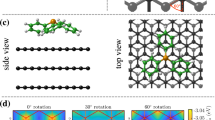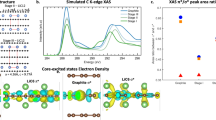Abstract
Raman scattering from the ∼ 1600 cm−1 graphitic phonons is used to study the stage evolution of graphite-H2SO4 in the first ∼ 1000 Å of the bulk during electrochemical intercalation. The Raman results are compared to staging kinetics in the deep bulk studied previously by 00/ x-ray diffraction. For low cell currents, which establish quasiequilibrium conditions, the c-face surface of the highly oriented pyrolytic graphite (HOPG) in contact with the reactant rapidly changes stage index to n − 1 just as the bulk completes stage n. We conclude that the intercalant must cross the c-face plate boundary of the HOPG, probably entering at either grain boundaries, microcracks, or steps in the plate surface. During stage transitions, the Raman lines are observed to remain Lorentzian in shape, with constant width, indicating that an ordered stage n − 1 compound grows at the expense of an ordered stage n compound. In studies of partially submerged HOPG plates, the surface above the acid level is found to stage last, although the plate surface just below the acid level stages first. Lateral diffusion of the sulfate anions from regions below, to regions above the acid level, is apparently impeded for reasons that are not understood. During portions of the electrochemical reaction requiring only hydrogen rearrangement in the intercalate layers (“overcharging”), Raman spectra taken from above and below the acid level are observed to evolve in concert, indicating the protons are not similarly impeded.
Similar content being viewed by others
References
The stage index n refers to the number of carbon (C) layers located between successive intercalate (1) layers (e.g., a stage 3 compound has the periodic stacking sequence …ICCCICCC… . For recent reviews of graphite intercalation compounds see M. S. Dresselhaus and G. Dresselhaus, Adv. Phys. 30, 139 (1981); and S. A. Solin, Adv. Chem. Phys. 49, 455 (1982).
J. O. Bessenhard, E. Wudy, H. Moewald, J. J. Nickl, W. Biberacher, and W. Foag, Synth. Met. 7, 185 (1983).
A. Metrot and J. E. Fischer, Synth. Met. 3, 201 (1981).
M. S. Dresselhaus and G. Dresselhaus, in Topics in Applied Physics, edited by M. Cardona and G. Guntherodt (Springer, Berlin, 1982), Vol. 51, Chap. 2.
A preliminary account of this work has been previously published: C. H. Olk, V. Yeh, F. J. Holler, and P. C. Eklund, in Materials Research Society Proceedings, edited by M. S. Dresselhaus, G. Dresselhaus, J. E. Fischer, and M. J. Moran (Elsevier, New York, 1983), Vol. 20, p. 259.
A. W. Moore, in Chemistry and Physics of Carbon, edited by P. L. Walker and P. A. Thrower (Dekker, New York, 1973), Vol. 11, p. 69.
J. G. Hooley. Mat. Sci. Eng. 31, 17 (1977).
P. Schaufhautl, J. Prakt. Chem. 21, 155 (1841).
S. Aronson, C. Frishberg, and G. Frankl, Carbon 9, 715 (1971).
S. Aronson, S. LeMont, and J. Weiner, Inorg. Chem. 10. 1296 (1971).
W. Rudorf, Adv. Inorg. Chem. Nucl. Chem. 1, 223 (1959).
J. Giergiel, Ph.D. thesis, University of Kentucky, 1982.
Reference 2 and references cited therein.
M. J. Bottonley, G. S. Parry, A. R. Ubbelohde, and D. Young, J. Chem. Soc. 1963, 5674.
W. R. Salaneck, C. F. Brucker. J. E. Fischer, and A. Metrot, Phys. Rev. B 24, 5037 (1981); see also the comments in Phys. Rev. B 28 (1982): L. B. Ebert and E. Appelman, p. 1637, and the reply by W. R. Salenck, C. F. Brucker, J. E. Fischer, and A. Metrot, p. 1639.
R. Fujii and K. Matsuo, Tanso 73, 44 (1973).
E. MacRae, A. Metrot, P. Willman, and A. Herold, Physica B 99, 541 (1980).
A. Metrot, P. Willmann, E. McRae, and A. Herold, Carbon 17, 182 (1979).
P. C. Eklund, E. T. Arakawa, J. L. Zarestky, W. A. Kamitakahara, and G. D. Mahan, Synth. Met. 12, 97 (1985).
H. Zabel and M. E. Misenheimer, Phys. Rev. B 24, 1443 (1983).
R. Nishitani, Y. Uno, and H. Suematsu, Phys. Rev. B 27, 6572 (1983).
W. A. Kamitakahara, P. C. Eklund, and J. L. Zarestky (private communication).
P. C. Eklund, J. G. Spolar, G. D. Mahan and E. T. Arakawa, D. M. Hoffman, and J. M. Zhang, Solid State Commun. 57(8), 567 (1986).
C. H. Olk and P. C. Eklund (private communication).
Author information
Authors and Affiliations
Rights and permissions
About this article
Cite this article
Eklund, P.C., Olk, C.H., Holler, F.J. et al. Raman scattering study of the staging kinetics in the c-face skin of pyrolytic graphite-H2SO4. Journal of Materials Research 1, 361–367 (1986). https://doi.org/10.1557/JMR.1986.0361
Received:
Accepted:
Published:
Issue Date:
DOI: https://doi.org/10.1557/JMR.1986.0361




